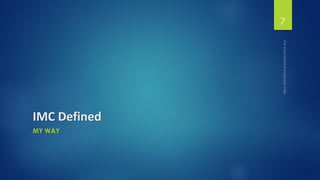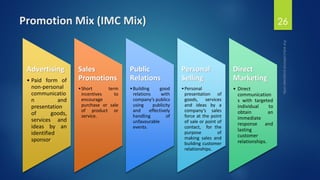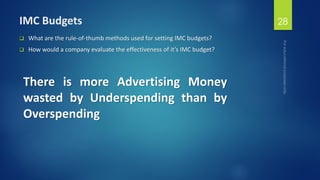Integrated Marketing Communication_Introduction
- 1. Integrated Marketing Communication A PRACTICAL AND MODERN OUTLOOK
- 2. Prabhjot Jolly Chairman, Soul Raaga Interactive Graduate – Advertising MBA – Marketing 15 years of work experience in Marketing Musician, Traveller, Husband of 1, Father of None ‘I am not a marketing guru, I am still a student”. 2 prabhjot_jolly@hotmail.com; prabh0612@yahoo.co.in; prabhjotjolly@gmail.com; Phone: +91 955 33 81 466 Skype: prabhjot_jolly Yahoo Messenger: prabh0612@yahoo.co.in
- 4. Nobody reads ads, people read what interests them. SOMETIMES IT’S AN AD. 4
- 5. Early to bed, early to rise. Work like hell to Advertise. 5
- 6. In advertising, Story-Telling is too often Story-Yelling!! 6
- 8. Analysing how consumers access marketing messages can help brands discover consumers' preferences for how to receive information. 8
- 9. 9 Purchase is just one type of action… What other actions can IMC ask consumers to take?
- 10. The success & failure of an IMC program depends upon: How you, as a marketer, perceive your product / service. How you perceive the target market. What perception do you have about target audience. What is your perception about the various tools of IMC. What is your perception about the monies to be spent on IMC program. What is / are your objective / objectives for designing the IMC program. 10
- 11. Integrated Marketing Communications Integrated Marketing Communications (IMC) is an approach used by organizations to brand and coordinate their communication efforts. The primary idea behind an IMC strategy is to create a seamless experience for consumers across different aspects of the marketing mix. The brand's core image and messaging are reinforced as each marketing communication channel works together in unity, rather than in isolation. The integration of marketing channels involves a process known as multi-channel retailing. 11
- 12. 12 As marketing efforts have shifted from mass advertising to niche marketing, companies have increasingly used IMC to develop cost-effective campaigns that deliver consumer value while reducing marketing costs. Marketing was once used as a one-way feed. Advertisers broadcasted their offerings and value proposition with little regard for the diverse needs, tastes, and values of consumers. Often, this "one size fits all" approach was costly and ineffective due to its general inability to measure results in terms of sales.
- 13. One of the major benefits of integrated marketing communications is that marketers can clearly and effectively communicate their brand's story and message across several communication channels to create brand awareness. IMC is also viewed as more cost-effective than mass media, since consumers are likely to interact with brands across various mediums and digital interfaces. As consumers spend more time on computers and mobile devices, marketers seek to weave together multiple exposures to their brands using different touch- points. Companies can then view the performance of their communication tactics as a whole instead of as fragmented pieces. IMC wraps communications around customers and helps them move through the various stages of the buying process. IMC can be instrumental to creating a seamless purchasing experience that spurs customers to become loyal, lifelong customers. 13
- 14. In the age of the Internet and digital communications, brands must carefully consider the timing and context of messages from consumers' point of view. Companies must ask themselves where the receiver is most likely to be receptive of the message. Besides market analysis, understanding the communications process, seasonal trends, purchasing cycles, or usage patterns can maximize the relevance of a brand's messaging. Marketers need to be critically aware of the Marketing Planning Process as a process. Evaluating the results. Monitoring & Control. 14
- 15. Objectives of IMC How do customers perceive marketing communications? Why are some media channels growing and others aren’t? How should companies use marketing metrics to plan for and measure IMC success? 15
- 16. Goal of IMC To generate short term financial returns and build long term brand value 16
- 17. Evolution of IMC 17 Mass marketing using mass communica tion Relationship marketing using integrated marketing communicatio n with a focus on interaction ?
- 18. Participants in the IMC Process Manufacturers / Sellers Promotion Agencies Wholesalers / Stockists Retailers Customers / Consumers 18
- 19. 5 step IMC Process 19 Customer Identification from Behavioural Data Valuation of Customers / Prospects Estimating Returns On Investment Budgeting, Allocation, Evaluation & Recycling Creating & Delivering Messages & Incentives
- 21. Message clutter is the reason why IMC exists Fragment the media Understand Consumer • Brand Value is very much like an Onion. It has layers and a core. The CORE is the user, who will stick with you till the very end. Create Brand Value 21 How to break the clutter?
- 22. Impact of IMC IMC plays a major role in: B2B (Business 2 Business) Interactions. Marketing channel communication. Customer focussed communication. Internally directed communication. 22
- 23. Tools of IMC Traditional Tools Television Advertising Radio Advertising Print Advertising Billboards & Hoardings Wall Paintings & Posters Modern Tools Social Media Marketing Digital Media Marketing Web Applications Mobile Applications Sales Promotions, Events & Roadshows Point Of Sale Marketing Point Of Contact Marketing Augmented Reality Marketing In-Film / In-Episode Promotions Celebrity Marketing Rural Marketing Participative Marketing** (Agency of the century – CONSUMER) Obsolete Tools Search Engine Optimisation Search Engine Marketing Wall Paintings Email Marketing 23
- 24. Components of IMC – The Burger Model 24
- 25. Marketing Mix – Combined together to form a cohesive marketing strategy Marketing Mix 4 Ps? An obsolete concept. 9 Ps? New Concept. Product Price Place Promotion Packaging People Process Perception Positioning 9 Ps of Marketing Product Price Place Promotion PackagingPeople Perception Process Positioning 25 IMC
- 26. Promotion Mix (IMC Mix) 26 Advertising • Paid form of non-personal communicatio n and presentation of goods, services and ideas by an identified sponsor. Sales Promotions •Short term incentives to encourage purchase or sale of product or service. Public Relations •Building good relations with company’s publics using publicity and effectively handling of unfavourable events. Personal Selling •Personal presentation of goods, services and ideas by a company’s sales force at the point of sale or point of contact, for the purpose of making sales and building customer relationships. Direct Marketing • Direct communication s with targeted individual to obtain an immediate response and lasting customer relationships.
- 27. What else apart from 4Ps (9Ps) drive marketing? 27 4Cs • Coherent • Consistent • Continuity • Complementary 4Ss • Synergistic • Synchronistic • Symbiotic • Systematic 4Es • Enhancing • Economical • Efficient • Effective
- 28. IMC Budgets What are the rule-of-thumb methods used for setting IMC budgets? How would a company evaluate the effectiveness of it’s IMC budget? 28 There is more Advertising Money wasted by Underspending than by Overspending
- 29. Marketing budgets aid in the planning of operations by forcing managers to prioritize activities and consider how conditions may change. When budgeting a IMC plan, it is important to allocate funds appropriately to the different facets of integrated marketing. The essential purposes of budgeting include: To control resources To communicate plans to various responsibility managers To motivate managers to strive to achieve budget goals To evaluate the performance of managers To provide visibility into the company's performance 29
- 30. Methods of setting up a marketing communication budget Affordability Can we afford to pay for advertising on the chosen media? If Yes, How much? If No, Why not? Percentage of sale What is the percentage of sale contribution does the each media tool give us? Is it economical? Will it give us the ROI? Competitive parity Is our budget competitively at par with our competition’s media spending? Objective & Task 30
- 31. Feed forward method or Feedback method? YOU DECIDE 31
- 32. 32 Attention Interest Desire Action Think Feel Do A I D A M O D E L o The "A" represents attention or awareness, and the ability to attract the attention of the consumers. o The "I" is interest and points to the ability to raise the interest of consumers by focusing on and demonstrating advantages and benefits (instead of focusing on features, as in traditional advertising). o The "D" represents desire. The advertisement convinces consumers that they want and desire the product or service because it will satisfy their needs. o The "A" is action, which leads consumers toward taking action by purchasing the product or service.
- 33. The AIDA model is an approach used by advertisers to describe the different phases of consumer engagement with an advertisement. New phrases such as “satisfaction” (AIDAS) and “confidence” (AIDCAS) have been added to the original AIDA model. These later models acknowledge the need to satisfy the customer so as to encourage repeat purchases and generate product referrals. Other modifications include the model's reduction to the three steps known as the CAB model. The steps include “Cognition” (awareness or learning), “Affect” (feeling, interest, or desire) and “Behaviour” (action). 33
- 34. Measuring IMC Success Understand the outcome they hope to achieve before they begin. Short Term or Long Term. Should be explicitly defined & measured. Frequency. Reach. Gross rating points. (Reach x Frequency). Web Tracking and Analytics. 34 Continuous monitoring of performance against predetermined targets is essential in achieving effective & efficient integrated marketing communications.
- 35. Common Mistakes marketers make while designing IMC programs. Most marketers focus their communication budgets, time and effort only on local advertising. While in the international markets, most marketers retain their “Local Advertising Agency” to communicate with a NON LOCAL MARKET. Thus, not being able to align their communication options for their international image. For example, IBM chooses OGILVY World Wide so as to have a unified brand image, logo, colours, etc. – “WRONG MOVE INTERNATIONALLY. GO LOCAL.” Meanwhile, McDonald’s and KFC have redesigned their menu and rates to fit the local audience tastes and purchasing power – “GOOD MOVE”. Many companies focus on integrated communications by ignoring organisational dimensions. Without adequate communication among departments; organisations will have great difficulties exchanging and sharing crucial information about target audiences. Only by aligning process of different functions can organisations develop real customer focus and customer orientation. 35
- 36. Exercise Can you think of any brand that is internationally recognised? That has been promoted via IMC? Has used new media? 36
- 37. Conclusion Don’t think too narrowly. Communication is not merely advertising. Think outside the box. “What does the brave new world of the 21st century hold for us?” 37




































